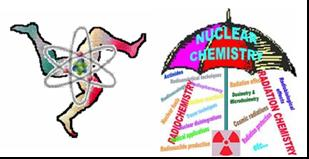Speaker
Mrs
Selen Ekim
(Ege University, Faculty of Science, Department of Chemistry, Division of Nuclear Chemistry, Bornova, Izmir 35100, Turkey)
Description
Nowadays, 2-deoxy-2-D-glucose radiolabeled with Fluorine-18 (18FDG) is widely used in cancer imaging studies as a popular PET radiopharmaceutical. For synthesis of 18FDG, 18F radionuclide is first produced by 18O (p, n) 18F nuclear reaction in a Medical Cyclotron. For this nuclear reaction, 18O enriched water (H218O) with about 97 % enrichment level is used as a target material in the Medical Cyclotrons. The main purpose of this study was to investigate the probable exchanges between 18O and 16O isotopes when H218O contacts considerably long time with air Oxygen. Thus, it would be determined that H218O should be avoided to contact with air Oxygen and to keep in an inert gas for long time storages or not. For this experiment, natural Oxygen and Argon gases were separately passed through H218O with 1 % 18O enrichment during long times up to about 8 days. Samples of about 1.5 mL taken from H218O with 1 % 18O enrichment have been analyzed by Isotopic Ratio Mass Spectrometry (IR-MS) technique in England. 18O analyses have showed that air Oxygen contact causes the decrease of 18O / 16O ratio and contrarily, Argon contact causes the increase of 18O / 16O ration. This means that H218O should be avoided to contact air Oxygen and during long time storages H218O is recommended to keep under an inert atmosphere like Argon. Otherwise, the enrichment level of H218O may considerably be decreased.
Author
Mrs
Selen Ekim
(Ege University, Faculty of Science, Department of Chemistry, Division of Nuclear Chemistry, Bornova, Izmir 35100, Turkey)
